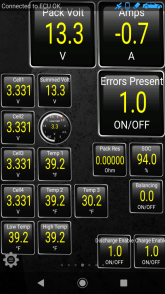I got a weak cell fault when testing, so I checked the BMS internal resistance measurements for the first time. They were pretty varied, with one cell over 1mohm, and others near 0.5mohm. I should be seeing around 0.2 max, and really 0.12 nominal. Though it will vary with SOC and temperature.
I bit the bullet and opened the cover. Nothing seemed out of place. So I took all the busbars off, and polished them with 1,000 grit paper. Easiest method was to oil my belt sander with a 1000 grit belt. I should have paid closer attention, but the 200 grit I used before was not up to the task, and I saw the scratches when I got a few passes in.
Reassembled and torqued to 35 in-lb. Results show below at nearly full charge. Much better. The values do fluctuate a bit, but should be fine for my application.

I bit the bullet and opened the cover. Nothing seemed out of place. So I took all the busbars off, and polished them with 1,000 grit paper. Easiest method was to oil my belt sander with a 1000 grit belt. I should have paid closer attention, but the 200 grit I used before was not up to the task, and I saw the scratches when I got a few passes in.
Reassembled and torqued to 35 in-lb. Results show below at nearly full charge. Much better. The values do fluctuate a bit, but should be fine for my application.





